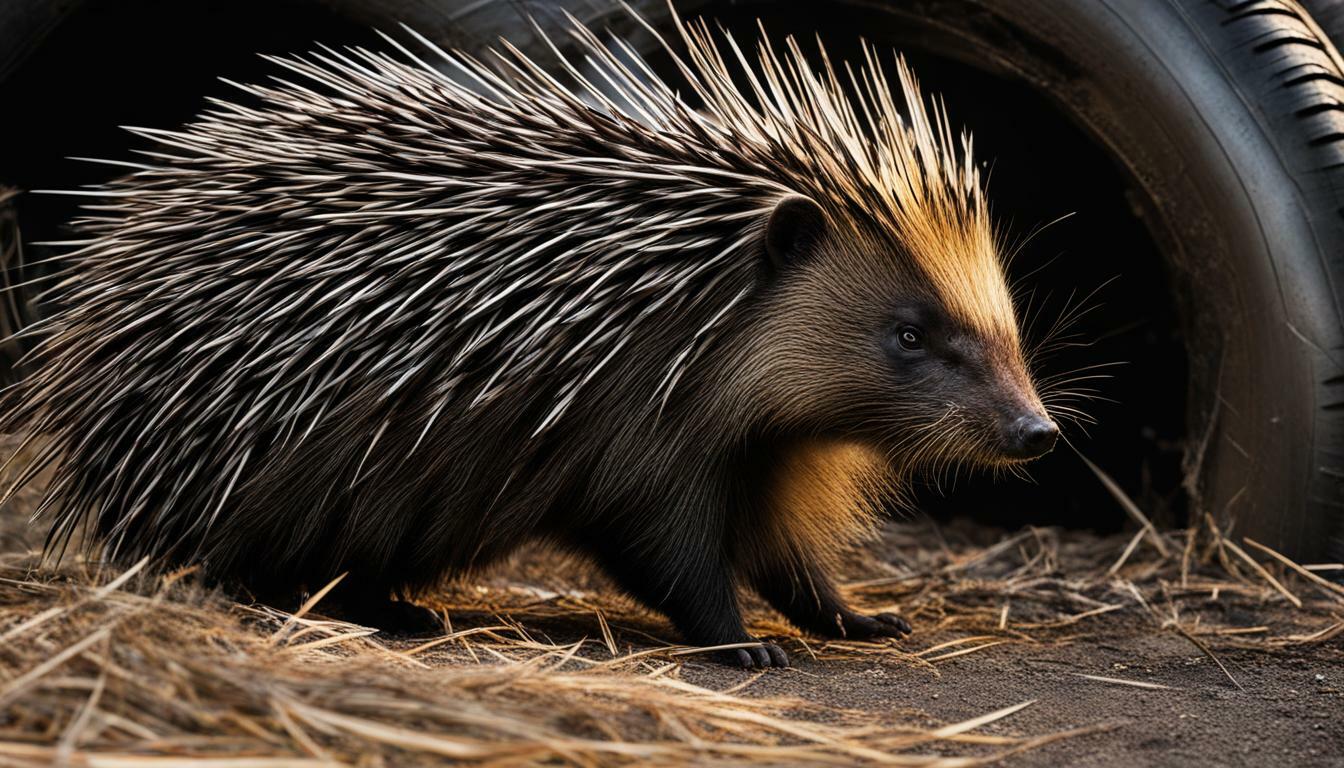Porcupine quills have the potential to puncture a tire under certain circumstances. While it is rare, tires can be susceptible to damage if they are worn out and a quill strikes the sidewall, causing air to escape quickly. This article will explore the factors that contribute to porcupine-related tire punctures and provide tips on how to prevent them.
Key Takeaways:
- Porcupine quills can puncture a tire if specific conditions are met.
- Tires that are worn out or have weaker structures are more vulnerable to damage.
- Porcupines release their quills upon contact as a defense mechanism.
- Running over a porcupine increases the chances of getting a flat tire.
- Preventing porcupine-related flat tires can be achieved by avoiding driving on worn-out tires and being vigilant on rural roads at night.
Understanding Porcupine Quills
Porcupine quills are sharp, barbed spines that the animal uses to protect itself from predators. These quills are an impressive defense mechanism, capable of inflicting pain and injury. Each quill is made of keratin, the same material found in human hair and nails, but it has specialized structures that make it unique. The quills have a tapered shape with a sharp tip and tiny backward-facing barbs along the shaft, which make them difficult to remove once embedded.
When a porcupine feels threatened, it will raise its quills to deter potential attackers. Contrary to popular belief, porcupines do not shoot their quills. Instead, they release them upon contact. When an animal or object comes into contact with a porcupine’s quills, the barbs on the quill shafts become embedded in the target. This mechanism allows the porcupine to defend itself effectively by creating a painful deterrent.
It is important to note that porcupine quills are not designed to puncture tires. However, under specific circumstances, they can cause damage. To puncture a tire, a quill needs to strike the tire sidewall in a way that it becomes dislodged, causing air to escape quickly. Tire punctures are more likely to occur with worn-out tires that have weaker structures. Newer, well-maintained tires are less vulnerable to quill-related damage due to their stronger construction.
| Porcupine Quills | Tire Puncture |
|---|---|
| Sharp, barbed spines | Possible, but rare |
| Used for self-defense | Can cause damage under specific conditions |
| Difficult to remove once embedded | Worn-out tires more susceptible to puncture |
If you encounter a porcupine on the road, it is best to maintain a safe distance and avoid running over it. Driving on worn-out tires increases the risk of quill-related flat tires, so regularly inspect your tires and replace them when necessary. When driving on rural roads at night, be extra cautious as porcupine activity may increase. By taking these precautions, you can reduce the chances of experiencing a porcupine-related flat tire.
The Structure of Car Tires
Car tires are designed to withstand various types of damage, but older tires may have weakened structures. Understanding the composition of car tires helps us grasp how porcupine quills can potentially damage them. Tires consist of several layers, each serving a specific purpose in providing grip, stability, and durability on the road.
The outer layer, known as the tread, is made of a tough rubber compound with patterns designed to enhance traction. Beneath the tread is the steel belt, which reinforces the tire and helps it maintain its shape. The steel belt is crucial in resisting punctures and distributing the force evenly when encountering sharp objects on the road.
However, despite their robust design, older tires tend to develop wear and tear, causing their structures to weaken. The rubber compound becomes less resilient, and the steel belt may start to fray. In such cases, the chances of porcupine quills puncturing the tire increase, especially if the quill strikes the sidewall and becomes dislodged, leading to a rapid loss of air pressure.
| Car Tire Structure | Function |
|---|---|
| Tread | Provides grip and traction |
| Steel Belt | Reinforces the tire and resists punctures |
| Sidewall | Provides lateral stability and protects tire from impacts |
| Inner Liner | Seals the tire and maintains air pressure |
To prevent porcupine-related flat tires, it is essential to ensure that your tires are in good condition. Regularly inspecting the tread wear, checking for signs of damage, and maintaining proper tire pressure are crucial steps in prolonging tire life and reducing the risk of punctures. Additionally, if you frequently drive in areas where encounters with porcupines are likely, it is advisable to be extra cautious, especially when driving on rural roads at night.
Factors Contributing to Puncture
For a porcupine quill to puncture a tire, it needs to strike the sidewall in a way that causes it to become dislodged. The structure and resilience of car tires play a crucial role in determining their vulnerability to porcupine quills. Tires are designed to withstand minor punctures from road debris, but older and worn-out tires are more susceptible to damage.
Porcupines do not shoot their quills, but rather release them upon contact as a defense mechanism. When a quill comes into contact with a tire, it can easily penetrate the sidewall if the conditions are right. However, the chances of getting a flat tire from porcupine quills are relatively rare, especially if you take certain precautions.
To prevent porcupine-related flat tires, it is important to drive on well-maintained tires. Worn-out tires with weaker structures are more likely to suffer punctures. Regularly inspecting your tires for signs of wear and tear, such as tread depth and sidewall damage, can help identify potential vulnerabilities. Additionally, being vigilant on rural roads, especially at night when porcupines are more active, can reduce the risk of encountering these prickly creatures.
Table: Tips for Preventing Porcupine-Related Flat Tires
| Tire Maintenance Tips | Driving Precautions |
|---|---|
|
|
While it is possible for porcupine quills to puncture a tire, it is important to note that the overall strength of car tires makes such incidents relatively uncommon. By taking proper precautions and maintaining your tires, you can minimize the risk of encountering porcupine-related flat tires and ensure a safer driving experience.
Porcupine Behavior and Quill Release
Porcupines do not shoot their quills, but rather, they release them as a defensive mechanism. When threatened, a porcupine will raise its quills and attempt to make physical contact with the predator. The quills have barbed ends that easily embed themselves in the skin of the predator when touched. This allows the quills to become lodged, causing pain and discomfort. In the case of a car driving over a porcupine, the pressure can cause the quills to dislodge and potentially puncture the tire.
It’s important to note that porcupines have a limited supply of quills, and they cannot shoot them out forcefully. Instead, the quills detach from the porcupine’s body upon contact. This natural defense mechanism helps the porcupine escape from predators and deter them from attacking. While the quills are effective in protecting the porcupine, they can pose a risk to vehicles when encountered on the road.
To minimize the chances of a porcupine-related flat tire, it’s essential to be cautious when driving in areas where porcupines are known to inhabit, especially during nighttime. Additionally, maintaining good tire condition is crucial. Worn-out tires with weaker structures are more susceptible to punctures, making them more vulnerable to quill-related damage. Regularly inspecting and replacing tires as needed can help mitigate the risk of tire punctures caused by porcupine quills.
| Tips for Preventing Porcupine-Related Flat Tires: |
|---|
| 1. Avoid driving on worn-out tires that have weakened structures. |
| 2. Be cautious when driving on rural roads, especially at night when porcupines are active. |
| 3. Regularly inspect tires for signs of damage and replace them as necessary. |
| 4. If encountering a porcupine on the road, slow down and give it ample space to move away. |
While it is possible to get a flat tire from a porcupine, it is relatively rare. The overall strength of car tires and the specific conditions required for the quills to puncture the tire sidewall contribute to the low occurrence of porcupine-related flat tires. By being vigilant and taking precautionary measures, drivers can effectively reduce the risk of experiencing a flat tire caused by porcupine quills.
Preventing Porcupine-Related Flat Tires
To minimize the chances of getting a flat tire from porcupine quills, it is important to take preventive measures. Porcupines don’t typically shoot their quills, but they release them upon contact as a defense mechanism. So, if you happen to run over a porcupine, especially one that raises its quills in defense mode, there is a risk of getting a flat tire.
One of the key preventive measures is to avoid driving on worn-out tires. Tires with weaker structures are more susceptible to damage, including punctures caused by porcupine quills. Regularly inspecting your tires for signs of wear and tear, and replacing them when necessary, can help reduce the likelihood of experiencing a flat tire.
Another important consideration is being extra vigilant when driving on rural roads at night. Porcupines are nocturnal animals, and their chances of crossing a road increase during the night. By staying alert and reducing your speed in areas where porcupines are known to inhabit, you can minimize the risk of encountering these prickly creatures and potentially damaging your tires.
| Tips for Preventing Porcupine-Related Flat Tires: |
|---|
| Inspect your tires regularly and replace worn-out ones. |
| Drive with extra caution on rural roads at night. |
| Keep a safe distance from porcupines on the road. |
| Avoid driving in areas known to have a high porcupine population. |
While it is possible to get a flat tire from a porcupine, it is important to note that such incidents are rare. Car tires are generally strong and can withstand minor punctures. By following these preventive measures, you can further reduce the chances of experiencing a tire puncture caused by porcupine quills, ensuring a smoother and hassle-free journey.
Rarity of Porcupine-Related Flat Tires
While it is possible to get a flat tire from a porcupine, it is a rare occurrence. The structure and resilience of car tires make them quite resistant to punctures, especially from small objects like porcupine quills. Tires are designed to withstand minor punctures without deflating completely, allowing drivers to safely pull over and address the issue.
Porcupines, as a defense mechanism, release their quills upon contact rather than shooting them. This means that for a porcupine quill to puncture a tire, it needs to strike the tire sidewall in a way that it becomes dislodged, causing air to escape quickly. Additionally, the vulnerability of tires also depends on their condition. Worn-out tires with weaker structures are more susceptible to damage, making them more likely to be punctured by porcupine quills.
Running over a porcupine increases the chances of getting a flat tire, especially if the porcupine raises its quills in defense mode. However, it’s important to note that porcupine-related flat tires are still relatively rare. Avoiding driving on worn-out tires and being vigilant on rural roads, especially at night when porcupines are more active, can help minimize the risk of encountering this issue.
| Possible Causes of Porcupine-Related Flat Tires |
|---|
| Worn-out tires with weaker structures |
| Porcupine quills striking the tire sidewall and becoming dislodged |
| Running over a porcupine in defense mode |
| Tires with existing punctures or damage |
In conclusion, while it is possible for porcupine quills to puncture car tires under certain conditions, such occurrences are generally rare. The strength and design of modern car tires, along with responsible driving habits such as avoiding worn-out tires and being cautious on rural roads, can greatly reduce the likelihood of experiencing a porcupine-related flat tire.
The Impact of Porcupine Quills on Tires
If a porcupine quill becomes embedded in a tire, it is crucial to remove it promptly to avoid further damage. Porcupine quills, with their sharp, barbed structure, have the potential to cause punctures in tires, especially if certain conditions are met. Tires, in general, are designed to be resilient and can withstand minor punctures. However, older tires with weaker structures are more vulnerable to damage from porcupine quills.
Porcupines do not shoot their quills, but rather release them upon contact as a defense mechanism. If you happen to run over a porcupine, the chances of getting a flat tire increase, especially if the porcupine raises its quills in defense mode. When a quill strikes the tire sidewall and becomes dislodged, it can cause air to escape quickly, leading to a flat tire.
To prevent porcupine-related flat tires, it’s important to take certain precautions. Avoid driving on worn-out tires, as they are more prone to damage. Be particularly vigilant when driving on rural roads at night, as porcupines are nocturnal animals and are more active during these hours. Additionally, it’s essential to address any quill-related damage promptly, as leaving a quill embedded in a tire can lead to further punctures or even tire failure.
Table: Tips for Preventing Porcupine-Related Flat Tires
| Tire Maintenance | Driving Precautions |
|---|---|
|
|
Conclusion
Porcupine quills have the potential to puncture a tire, but the conditions for it to happen are specific, making it a rare occurrence. To understand why this happens, we need to examine both the structure of porcupine quills and the resilience of car tires.
Porcupine quills are not shot out like projectiles; rather, they are released upon contact as a defense mechanism. This means that running over a porcupine increases the chances of getting a flat tire, especially if the porcupine raises its quills in defense mode. If a porcupine quill strikes a car tire sidewall in a way that it becomes dislodged, it can cause air to escape quickly, resulting in a flat tire.
However, it is important to note that car tires are generally strong and can withstand minor punctures. The likelihood of a porcupine quill puncturing a tire is higher when the tire is worn out and has a weaker structure. Therefore, one of the best ways to prevent porcupine-related flat tires is to avoid driving on worn-out tires.
Being vigilant on rural roads at night is also crucial, as porcupines are more active during these times. By maintaining a safe speed and staying alert for any signs of porcupines on the road, you can reduce the risk of encountering these quilled creatures and potentially getting a flat tire.
In conclusion, while it is possible for porcupine quills to puncture a tire, it is a rare occurrence. The specific conditions required, such as worn-out tires and precise quill contact, make it less likely to happen. By practicing good tire maintenance and being mindful of porcupine habitats, you can minimize the chances of experiencing a porcupine-related flat tire.
FAQ
Can porcupine quills puncture a tire?
Yes, under certain conditions, porcupine quills can puncture a car tire.
What conditions are required for porcupine quills to puncture a tire?
The tires need to be worn out, and the quill needs to strike the tire sidewall in a way that it becomes dislodged, causing air to escape quickly.
Are all tires susceptible to porcupine quill damage?
Tires are generally strong and can withstand minor punctures, but older tires with weaker structures are more susceptible to damage.
Do porcupines shoot their quills?
No, porcupines release their quills upon contact as a defense mechanism.
Does running over a porcupine increase the chances of a flat tire?
Yes, running over a porcupine increases the chances of getting a flat tire, especially if the porcupine raises its quills in defense mode.
How can I prevent flat tires caused by porcupine quills?
Avoid driving on worn-out tires and be vigilant on rural roads at night.
How rare is it to get a flat tire from porcupine quills?
While it is possible to get a flat tire from a porcupine, it is rare due to the overall strength of car tires.




